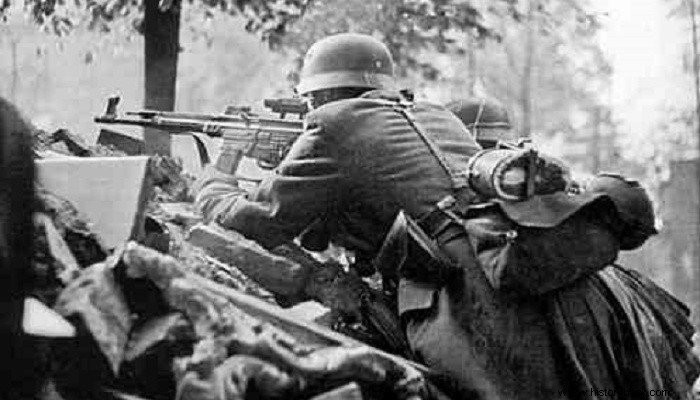
The Grenadier Division (MG) "Scharnhorst" began to be formed on March 30, 1945, a few days before the end of the Second World War in Europe. Nevertheless it proved to be one of the elite large units of the German army in this final phase of the war fighting heroically, as if Germany were not losing the war, to rescue soldiers and civilians from the Soviets.
The division was made up of remnants of the 167th and 340th People's Grenadier Divisions, students of the Dassau Engineer School, men of the 412th People's Artillery Corps, men of the Luftwaffe and students of officer and non-commissioned officer schools of the 11th Military Division. The division's fusilier battalion was detached from the "Potsdam" MP.
The division, characterized as a "grenadier division", had three grenadier regiments, each of two battalions, the personnel of which, at a percentage of 80%, were candidate reserve officers and candidate reserve ranks. The men carried everything from K98 repeating rifles to Sturmgewehr 44 assault rifles, MG34 and MG42 machine guns, Panzerfaust and Panzerschreck anti-tank launchers (the German Bazooka) , mortars, anti-tank, (few) anti-aircraft and field guns in its artillery regiment. The division's anti-tank battalion had seven Jagdpanzer 38(t) Hetzer tank destroyers.
The division began massing between 4 and 7 April southeast of Magdeburg and joined the XX Army Corps (SS) of the newly formed 12th Army which was tasked with holding back the Americans on the Elbe River. On 11 April the division was reinforced with the 1170th Assault Rifle Squadron with 19 StuG and 12 StuH.
The said squadron together with the 1st Scharnhorst Grenadier Regiment successfully countered the American attempts to extend their bridgehead on the Elbe, repelling them for four consecutive days. After this the Americans did not attempt again as they had been ordered to leave Berlin to the Soviets. In the meantime the Soviet offensive against the German 9th Army had managed to break through the German positions. The Soviets also broke through the German positions south of the 9th Army threatening the army and Berlin with encirclement.
On 22 April as the 9th Army was cut off and encircled, Hitler loyalist Field Marshal Keitel floated the idea of moving the 12th Army from the Elbe to Berlin. Keitel stated that he would leave immediately for the headquarters of the 12th Army to personally convey Hitler's orders to its commander, General Wenk. The 12th Army should turn its back on the Americans and moving east, join General Bush's encircled 9th Army. Both armies would then attempt to break the Russian front and achieve a link up with the besiegers of Berlin.
When he received Keitel's visit, Wenk promised to move to rescue the "Führer". But Venk he was under no illusions. Knowing the small possibilities of his forces against the Soviet road-pavers he decided to move his XX SS towards Berlin with the aim of opening the escape route of the encircled 9th Army and thousands of civilians. The tip of the spear of the XX SS was the "Scharnhorst" which had fought so well against the Americans.
Truly the division fought heroically again and managed to save part of the 9th Army and thousands of civilians, covering the German bridgehead on the east bank of the Elbe to the end until those who could cross. Her men were the last to cross the river. The division surrendered, on May 2, to the Americans.
The division had received its name from its excellent, namesake Hanoverian general of the Napoleonic Wars who rose to glory in the service of Prussia. The commander of the division was lieutenant general Heinrich Getz. The division had the 1st, 2nd and 3rd Scharnhorst Grenadier Regiments, Scharnhorst Artillery Regiment, Scharnhorst Anti-Tank Battalion, Scharnhorst Reconnaissance Battalion (Fusiliers) Scharnhorst, Scharnhorst Engineer Battalion, forwarding section and services.
